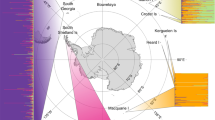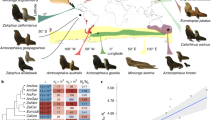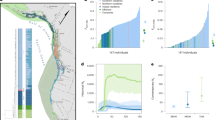Abstract
Global environmental change is expected to alter selection pressures in many biological systems1,2,3, but the long-term molecular and life history data required to quantify changes in selection are rare4. An unusual opportunity is afforded by three decades of individual-based data collected from a declining population of Antarctic fur seals in the South Atlantic. Here, climate change has reduced prey availability and caused a significant decline in seal birth weight. However, the mean age and size of females recruiting into the breeding population are increasing. We show that such females have significantly higher heterozygosity (a measure of within-individual genetic variation) than their non-recruiting siblings and their own mothers. Thus, breeding female heterozygosity has increased by 8.5% per generation over the last two decades. Nonetheless, as heterozygosity is not inherited from mothers to daughters, substantial heterozygote advantage is not transmitted from one generation to the next and the decreasing viability of homozygous individuals causes the population to decline. Our results provide compelling evidence that selection due to climate change is intensifying, with far-reaching consequences for demography as well as phenotypic and genetic variation.
This is a preview of subscription content, access via your institution
Access options
Subscribe to this journal
Receive 51 print issues and online access
$199.00 per year
only $3.90 per issue
Buy this article
- Purchase on Springer Link
- Instant access to full article PDF
Prices may be subject to local taxes which are calculated during checkout



Similar content being viewed by others
References
Parmesan, C. Ecological and evolutionary responses to recent climate change. Annu. Rev. Ecol. Evol. Syst. 37, 637–669 (2006)
Hoffmann, A. A. & Sgro, C. M. Climate change and evolutionary adaptation. Nature 470, 479–485 (2011)
Franks, S. J. & Hoffman, A. A. Genetics of climate change adaptation. Annu. Rev. Genet. 46, 185–208 (2012)
Gienapp, P., Teplitsky, C., Alho, J. S., Mills, J. A. & Merila, J. Climate change and evolution: disentangling environmental and genetic responses. Mol. Ecol. 17, 167–178 (2008)
Chapman, J. R., Nakagawa, S., Coltman, D. W., Slate, J. & Sheldon, B. C. A quantitative review of heterozygosity-fitness correlations in animal populations. Mol. Ecol. 18, 2746–2765 (2009)
Samollow, P. B. & Soulé, M. E. A case of stress related heterozygote superiority in nature. Evolution 37, 646–649 (1983)
Mitton, J. B., Schuster, W. S. F., Cothran, E. G. & De Fries, J. C. The correlation between the individual heterozygosity of parents and their offspring. Heredity 71, 59–63 (1993)
Hoffman, J. I., Boyd, I. L. & Amos, W. Exploring the relationship between parental relatedness and male reproductive success in the Antarctic fur seal Arctocephalus gazella. Evolution 58, 2087–2099 (2004)
Hoffman, J. I., Forcada, J., Trathan, P. N. & Amos, W. Female fur seals show active choice for males that are heterozygous and unrelated. Nature 445, 912–914 (2007)
Hoffman, J. I., Forcada, J. & Amos, W. Getting long in the tooth: a strong positive correlation between canine size and heterozygosity in the Antarctic fur seal Arctocephalus gazella. J. Hered. 101, 527–538 (2010)
Murphy, E. J. et al. Climatically driven fluctuations in Southern Ocean ecosystems. Proc. R. Soc. B 274, 3057–3067 (2007)
Forcada, J., Trathan, P. N. T., Reid, K. & Murphy, E. J. The effects of global climate variability in pup production of antarctic fur seals. Ecology 86, 2408–2417 (2005)
Meredith, M. P., Murphy, E. J., Hawker, E. J., King, J. C. & Wallace, M. I. On the interannual variability of ocean temperatures around South Georgia, Southern Ocean: Forcing by El Niño/Southern Oscillation and the Southern Annular Mode. Deep-Sea Res. II 55, 2007–2022 (2008)
Forcada, J., Trathan, P. N. & Murphy, E. J. Life history buffering in Antarctic mammals and birds against changing patterns of climate and environmental variation. Glob. Change Biol. 14, 2473–2488 (2008)
Aparicio, J. M., Ortego, J. & Cordero, P. J. What should we weigh to estimate heterozygosity, alleles or loci? Mol. Ecol. 15, 4659–4665 (2006)
Eberhardt, L. L. A paradigm for population analysis of long-lived vertebrates. Ecology 83, 2841–2854 (2002)
Caswell, H. Matrix Population Models 2nd edn (Sinauer Associates, 2001)
Di Fonzo, M. M. I., Pelletier, F., Clutton-Brock, T. H., Pemberton, J. M. & Coulson, T. The population growth consequences of variation in individual heterozygosity. PLoS ONE 6, e19667 (2011)
Easterling, M. R., Ellner, S. P. & Dixon, P. M. Size-specific sensitivity: applying a new structured population model. Ecology 81, 694–708 (2000)
Coulson, T., Tuljapurkar, S. & Childs, D. Z. Using evolutionary demography to link life history theory, quantitative genetics and population ecology. J. Anim. Ecol. 79, 1226–1240 (2010)
Jiménez, J. A., Hughes, K. A., Alaks, G., Graham, L. & Lacy, R. C. An experimental study of inbreeding depression in a natural habitat. Science 266, 271–273 (1994)
Hoffman, J. I., Tucker, R., Clark, M. S., Forcada, J. & Slate, J. Rates of assay success and genotyping error when single nucleotide polymorphism genotyping in non-model organisms: a case study in the Antarctic fur seal. Mol. Ecol. Resour. 12, 861–872 (2012)
Szulkin, M., Bierne, N. & David, P. Heterozygosity-fitness correlations: a time for reappraisal. Evolution 64, 1202–1217 (2010)
Hoffman, J. I. et al. High-throughput sequencing reveals inbreeding depression in a natural population. Proc. Natl Acad. Sci. USA 111, 3775–3780 (2014)
Meredith, M. P. & King, J. C. Rapid climate change in the ocean west of the Antarctic Peninsula during the second half of the 20th century. Geophys. Res. Lett. 32, L19604 (2005)
Hoffmann, A. A. & Hercus, M. J. Environmental stress as an evolutionary force. Bioscience 50, 217–226 (2000)
Acknowledgements
The authors thank the many fieldworkers who have contributed to data collection over the years. We are also grateful to W. Amos, J. Bascompte, M. Boerner, K. Dasmahapatra, O. Krüger and I. Staniland for advice and feedback on the manuscript, together with T. Coulson for helpful referee comments. This work contributes to the Long Term Monitoring and Survey project and Ecosystems project of the British Antarctic Survey, Natural Environment Research Council, part of the Polar Science for Planet Earth programme. The genetic work was supported by a Marie Curie FP7-Reintegration-Grant within the 7th European Community Framework Programme (PCIG-GA-2011-303618) and a Deutsche Forschungsgemeinschaft standard grant (HO 5122/3-1) awarded to J.I.H.
Author information
Authors and Affiliations
Contributions
J.F. conceived, designed and conducted the biometric, mark–recapture, demographic and population modelling and subsequent phenotypic and evolutionary demographic analysis; J.I.H. generated and analysed the genetic data. The authors jointly interpreted the results and wrote the manuscript.
Corresponding author
Ethics declarations
Competing interests
The authors declare no competing financial interests.
Extended data figures and tables
Extended Data Figure 1 Antarctic fur seal life cycle and directed acyclic graph of multi-event mark–recapture models used to estimate vital rates.
a, In the life cycle graph, nodes correspond to stages and arrows to probabilities of transition ( ) between stages (Supplementary Information), from year t to t + 1. Subscripts are for ages 0, for weanlings, to 6 at full physical maturity, and breeding stages. P6 acts as a terminal node for individuals observed alive but never recruited. Fertilities (f) are female weanlings contributed by females breeding at t + 1. b, The acyclic graph shows intermediate sets of stages which are connected by rows, with each stage in a row being represented by a node. Different transitions are represented by arrows linking intermediate states. Nodes are different in a and b. See Supplementary Information for definitions of stages and vital rates.
) between stages (Supplementary Information), from year t to t + 1. Subscripts are for ages 0, for weanlings, to 6 at full physical maturity, and breeding stages. P6 acts as a terminal node for individuals observed alive but never recruited. Fertilities (f) are female weanlings contributed by females breeding at t + 1. b, The acyclic graph shows intermediate sets of stages which are connected by rows, with each stage in a row being represented by a node. Different transitions are represented by arrows linking intermediate states. Nodes are different in a and b. See Supplementary Information for definitions of stages and vital rates.
Extended Data Figure 2 Variation in survival probability and breeding propensity (fecundity) with variation in the SAM index.
Panel a shows survival of first-year pre-breeders in red, including its variation with homozygosity weighted by locus (HL); averaged survival for years 1 to 6 is shown in blue. Panel b shows age-specific survival for recruiting seals, and panel c the survival for adults (that is, seals with previous breeding experience) with variation by stages defined according to previous breeding outcomes (successful, failed, or deferred breeding). Panel d shows inter-annual breeding propensity for recently recruited seals and for experienced breeders. All vertical bars show 95% CIs.
Extended Data Figure 3 Sensitivity of the population growth rate (log(λ)) to changes in statistical parameters of vital rates describing the survival and fertility functions in integral projection models.
Panels a–c show sensitivity to survival of first year females (a), females of ages 1 to 7 (b; continuous lines for pre-breeders and dashed for breeders), and ages 8 or above (c). Panel d shows sensitivity to recruitment (α) and panel e shows sensitivity to inheritance (H(h′|h)), with a dashed line for the variance intercept. Panels f and g show sensitivity to fecundity for ages 3 to 7, and 8 or above, respectively. Panels h and i show sensitivities to breeding success (ς) for ages 3 to 7, and 8 or above, respectively. Red lines are intercepts, black and grey are linear and quadratic SAM index effects, green are homozygosity weighted by locus (HL) effects, and blue are linear age effects. The scale of the vertical axes in panels a–c and e are an order of magnitude higher than in the other panels.
Extended Data Figure 4 Sensitivity of the mean population homozygosity weighted by locus ( ) to changes in statistical parameters of the vital rates describing the survival and fertility functions in integral projection models.
) to changes in statistical parameters of the vital rates describing the survival and fertility functions in integral projection models.
Panels a–d show sensitivity to survival of first year females (a), pre-breeders of ages 1 to 7 (b), breeders aged 8 or above (c), and breeders of ages 3 to 7 (d). Panel e shows sensitivity to recruitment (α), and panels f and g show sensitivity to fecundity for ages 3 to 7, and ages 8 or above, respectively. Panel h shows sensitivity to inheritance (H(h′|h)), where the dashed line indicates the variance parameter. Panels i and j show sensitivity to breeding success for ages 3 to 7, and ages 8 or above, respectively. Colours are red for intercept, black and grey for linear and quadratic SAM index effects, respectively, green for HL effects, and blue for linear age effects.
Extended Data Figure 5 Sensitivity of the strength of viability selection (VS) on homozygosity weighted by locus (HL) to statistical parameters of vital rates describing the survival and fertility functions of integrated projection models.
Panels a–d show sensitivity to survival of first-year females (a), pre-breeders of ages 1 to 7 (b), breeders of ages 3 to 7 (c) and breeders of ages 8 or above (d). Panel e shows sensitivity to recruitment (α) and panels f and g show sensitivity to fecundity for ages 3 to 7, and 8 or above, respectively. Panel h shows the sensitivity to inheritance (H(h′|h)), where the dashed line is for the variance parameter. Panels i and j show sensitivities to breeding success for ages 3 to 7, and ages 8 or above, respectively. Colours are red for intercept, black and grey for linear and quadratic SAM index effects, respectively, green for HL effects, and dark blue and light blue for linear and quadratic age effects, respectively. Note that the scale of the vertical axis in panel a is an order of magnitude larger than the other panels.
Extended Data Figure 6 Long-term trend in breeding female homozygosity decomposed by locus.
Coloured lines show mean annual homozygosity weighted by locus (HL) values for each of the loci exhibiting significant declining trends (see also Extended Data Table 3). The equivalent relationship for multilocus HL is shown below for reference, with the shaded area representing the 95% confidence interval of a fitted linear model of HL against year, and the vertical bars representing 95% confidence limits of the annual estimates.
Supplementary information
Supplementary Information
This file contains Supplementary Methods and additional references. (PDF 403 kb)
Rights and permissions
About this article
Cite this article
Forcada, J., Hoffman, J. Climate change selects for heterozygosity in a declining fur seal population. Nature 511, 462–465 (2014). https://doi.org/10.1038/nature13542
Received:
Accepted:
Published:
Issue Date:
DOI: https://doi.org/10.1038/nature13542
This article is cited by
-
Patterns of occurrence of the sub-Antarctic fur seal Arctocephalus tropicalis (Gray 1872) in Southern Brazil: climatic and environmental associations
Polar Biology (2024)
-
Quantifying Antarctic krill connectivity across the West Antarctic Peninsula and its role in large-scale Pygoscelis penguin population dynamics
Scientific Reports (2023)
-
Untangling unexpected terrestrial conservation challenges arising from the historical human exploitation of marine mammals in the Atlantic sector of the Southern Ocean
Ambio (2023)
-
Multi-omics for studying and understanding polar life
Nature Communications (2023)
-
Intronic primers reveal unexpectedly high major histocompatibility complex diversity in Antarctic fur seals
Scientific Reports (2022)
Comments
By submitting a comment you agree to abide by our Terms and Community Guidelines. If you find something abusive or that does not comply with our terms or guidelines please flag it as inappropriate.




 ) to changes in statistical parameters of the vital rates describing the survival and fertility functions in integral projection models.
) to changes in statistical parameters of the vital rates describing the survival and fertility functions in integral projection models.